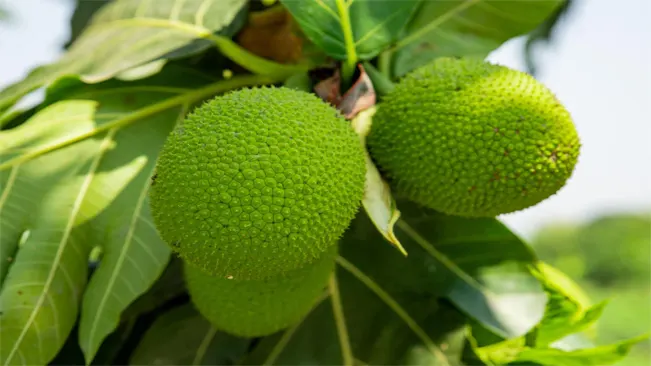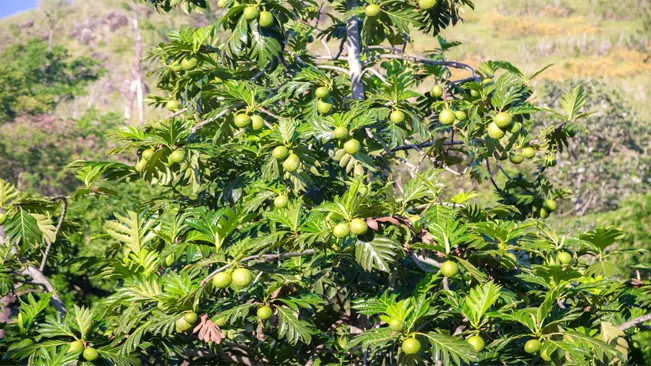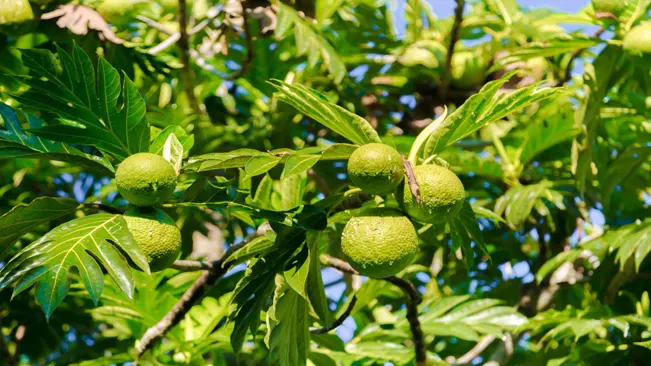How to Grow Breadfruit: Essential Tips for a Thriving Tree
- March 16, 2024
- 0 comment
Starting with How to Grow Breadfruit, explore the journey of cultivating Artocarpus altilis, a nutritious tropical fruit from the Pacific Islands, known for its unique flavor and cultivation ease. This article will guide you through the essential steps and considerations for successfully growing breadfruit.

Benefits of Breadfruit
| Benefit | Description |
|---|---|
| Nutritional Value | Breadfruit is rich in carbohydrates and dietary fiber, making it an excellent energy source. It also contains moderate amounts of protein and is low in fat. |
| Vitamins | This fruit is a good source of vitamins, especially vitamin C, which aids in immune system function, and B vitamins, including thiamine (B1), riboflavin (B2), niacin (B3), and pyridoxine (B6). |
| Minerals | Breadfruit contains essential minerals such as potassium, which helps regulate blood pressure, magnesium for muscle and nerve function, and iron, crucial for red blood cell production. |
| Antioxidants | It has antioxidants like flavonoids and carotenoids that protect against cellular damage and reduce the risk of chronic diseases. |
| Dietary Fiber | High in dietary fiber, breadfruit is beneficial for digestion and can help in maintaining a healthy weight. |
| Versatility in Cooking | Breadfruit can be used in a variety of culinary applications, from baking and frying to making snacks and desserts, making it a versatile ingredient in the kitchen. |
| Gluten-Free | It is a naturally gluten-free food, making it a suitable carbohydrate source for those with gluten intolerance or celiac disease. |
| Sustainable Crop | Breadfruit trees are perennial and require relatively low maintenance, making them a sustainable and environmentally friendly food source in suitable climates. |
Before diving into the cultivation process, it’s important to understand the nature of breadfruit. This large, round, starchy fruit is closely related to jackfruit and has a similar appearance, but its uses in the kitchen are more akin to potatoes. The trees can reach up to 26 meters in height and are also valued for their timber.
List on How To Grow Breadfruit
- Choosing the Right Environment
- Soil and Location
- Planting Breadfruit
- Watering and Fertilization
- Pruning and Care
- Harvesting
Choosing the Right Environment

Climate Requirements
- Temperature Range: Breadfruit trees flourish in temperatures ranging from 60°F (15°C) to 100°F (38°C), but they thrive best at an average temperature around 85°F (29°C). They are sensitive to temperature fluctuations, especially colder ones.
- Tropical Conditions: These trees are native to tropical regions and therefore require a consistently warm and humid climate. They do not fare well in areas with significant seasonal changes, especially cold winters.
- Frost Sensitivity: Frost is particularly harmful to breadfruit trees. Even a light frost can damage or kill young trees, and mature trees are not significantly more resistant. Areas prone to frost are unsuitable for breadfruit cultivation.
Rainfall and Humidity
- Rainfall: Consistent and adequate rainfall is essential for breadfruit. The tree benefits from regular, evenly distributed rain throughout the year. It generally needs an annual rainfall between 60 inches (1,500 mm) and 100 inches (2,500 mm).
- Humidity: High humidity levels are beneficial for breadfruit trees. They help in maintaining soil moisture and provide the necessary environmental moisture for optimum growth. Dry, arid conditions can be detrimental to the health of the tree.
Soil and Topography
- Soil Type: Breadfruit trees prefer rich, deep, well-drained soil. They do well in a variety of soil types, including loams, sandy loams, and even clayey soils, as long as there is good drainage.
- Soil pH: The ideal soil pH for breadfruit trees ranges from slightly acidic to neutral (pH 6.0 to 7.0).
- Topography: They can be planted in a range of topographical settings, including slopes, as long as there is adequate soil depth and moisture. However, areas prone to waterlogging should be avoided.
Environmental Considerations
- Wind: While breadfruit trees can tolerate some wind, they are best planted in locations that are somewhat sheltered to avoid damage to the tree and fruit.
- Microclimate: Creating a favorable microclimate, such as planting in groups or near other trees for wind protection and maintaining soil moisture, can enhance growth.
- Altitude: Breadfruit trees usually thrive at lower altitudes but can be grown up to altitudes of about 2,000 feet (600 meters). However, fruit production tends to decrease at higher elevations.
Soil and Location
Plant your breadfruit tree in a location that gets plenty of sunlight. The soil should be rich, deep, and well-drained. Breadfruit trees are susceptible to waterlogging, so avoid areas where water tends to accumulate.
Soil Characteristics
- Richness: Breadfruit trees flourish in nutrient-rich soil. This richness is often achieved through organic matter, like compost or decomposed leaves, which enriches the soil with essential nutrients.
- Depth: Deep soil is important because it allows the roots of the breadfruit tree to penetrate and spread easily, which is vital for stability and nutrient uptake. Shallow soils can restrict root growth and negatively impact the tree’s health and productivity.
- Drainage: Well-drained soil is crucial. While breadfruit trees need a consistent moisture supply, they are prone to root rot in waterlogged conditions. Good drainage ensures that excess water can escape, preventing potential root issues.
Location Requirements

- Sunlight: Breadfruit trees require full sunlight for optimal growth. This means the chosen location should have unobstructed exposure to sunlight for most of the day. Sunlight is essential for photosynthesis, which drives the tree’s growth and fruit production.
- Air Circulation: Good air circulation is beneficial for the health of the tree. It helps in preventing fungal diseases which can be prevalent in humid, stagnant conditions.
- Space: Considering their potential size, breadfruit trees should be planted in a spacious area. They can reach up to 85 feet in height and develop broad canopies. Adequate spacing between trees (about 30 feet or more) is necessary to prevent overcrowding and competition for nutrients and light.
Planting Breadfruit
Propagation Techniques
- Root Cuttings: This involves taking a cutting from a mature tree’s root and planting it to grow a new tree. This method is generally more successful when the cutting is taken from a healthy, vigorous parent tree.
- Air Layering: A somewhat more advanced technique, air layering involves partially cutting a branch and encouraging it to form roots while still attached to the parent tree. Once rooted, this branch can be cut off and planted as a new tree.
Both methods ensure that the new trees inherit the characteristics of the parent tree, which is particularly important for maintaining the quality of the fruit.
Choosing Saplings
- When purchasing a sapling from a nursery, look for healthy, disease-free plants. The sapling should have a strong, well-developed root system and show signs of new growth in leaves and branches.
Planting Process
- Preparation: Before planting, ensure the soil is well-prepared. This can include adding organic matter or compost to enrich the soil.
- Digging the Hole: The hole should be twice the size of the root ball to give the roots plenty of room to expand. Loosening the soil around the hole also helps the roots to penetrate the surrounding soil.
- Planting: Carefully place the sapling in the center of the hole. Fill the hole with soil, gently compacting it to eliminate air pockets. The soil line should be level with the base of the trunk, not covering the trunk itself.
- Watering: After planting, water the sapling thoroughly. This helps settle the soil around the roots and provides necessary hydration for the young tree.
Spacing Considerations
- Breadfruit trees can grow quite large and need sufficient space for their roots and canopies. The recommended spacing of about 30 feet between trees prevents competition for nutrients and light, ensuring healthy growth and optimal fruit production.
- Proper spacing also facilitates air circulation, which is crucial in preventing fungal diseases.
Watering and Fertilization
Regular watering is crucial, especially in the first few years of growth. However, once established, breadfruit trees are relatively drought-tolerant. Use organic mulch to retain soil moisture and control weeds. Fertilize with a balanced, organic fertilizer during the growing season.
Watering Breadfruit Trees
- Young Trees: For the first few years after planting, regular and consistent watering is vital. Young trees are establishing their root systems and require sufficient moisture to do so. The frequency of watering depends on the climate and soil type, but a general rule is to keep the soil moist, not waterlogged.
- Mature Trees: Once established, breadfruit trees are quite resilient and can tolerate periods of drought. However, they still benefit from regular watering, especially during dry spells and the fruit development phase. The goal is to maintain an even level of soil moisture.
- Techniques: Deep watering, which encourages the roots to grow deeper and become more drought-resistant, is an effective approach. Drip irrigation systems can be very beneficial for providing consistent moisture without over-watering.
- Signs of Over/Under Watering: Over-watering can lead to root rot, while under-watering might cause the leaves to wilt and drop. Adjust your watering schedule based on these signs and the seasonal needs of the tree.
Fertilization of Breadfruit Trees
- Type of Fertilizer: A balanced, organic fertilizer is recommended. This typically means a fertilizer with equal proportions of nitrogen, phosphorus, and potassium (N-P-K). Additionally, incorporating organic matter like compost can improve soil fertility and structure.
- Frequency: Fertilize your breadfruit tree during the growing season, which is usually spring and summer. Younger trees may benefit from more frequent fertilization (e.g., every 3-4 months) to support their rapid growth, while mature trees can be fertilized once or twice a year.
- Application: Apply the fertilizer around the base of the tree, extending to the drip line (the area directly below the outer circumference of the tree branches). Avoid placing fertilizer too close to the trunk to prevent burn.
- Mulching: Using organic mulch around the base of the tree not only helps retain soil moisture but also gradually adds nutrients to the soil as the mulch decomposes. It also keeps weeds at bay, which can compete with the tree for nutrients and water.
- Monitoring Tree Health: Observe the tree’s growth and foliage. If the tree appears stunted or the leaves are yellowing (and it’s not due to over/under-watering), it might indicate a nutrient deficiency. Adjust your fertilization practice accordingly.
Pruning and Care
Pruning
While breadfruit trees do not require intensive pruning, proper care in this area is still important for their overall health and productivity:
- Removing Dead or Diseased Branches: Regularly inspect the tree for any branches that are dead, diseased, or damaged. These should be removed promptly to prevent the spread of disease and to encourage the growth of healthy branches.
- Shaping the Tree: Occasionally, you might need to prune for shaping purposes, especially in younger trees. This helps in forming a strong, well-structured tree. However, excessive pruning should be avoided as it can stress the tree and reduce fruit production.
- Thinning the Canopy: In some cases, thinning out a dense canopy can improve air circulation and sunlight penetration, which are crucial for the health of the tree and the quality of the fruit.
- Pruning Tools: Always use clean, sharp tools for pruning to make clean cuts and reduce the risk of infecting the tree.
Care
Apart from pruning, breadfruit trees require ongoing care to thrive:
- Watering: Young trees need consistent watering until they are well established. Mature trees are more drought-tolerant but still benefit from regular watering, especially in dry conditions.
- Fertilization: Apply a balanced organic fertilizer during the growing season to support healthy growth. The exact needs may vary based on soil quality and local conditions.
- Mulching: Applying organic mulch around the base of the tree helps retain soil moisture, control weeds, and add nutrients to the soil as it decomposes.
- Pest Control: Breadfruit trees can be susceptible to pests like fruit flies. Monitor the trees regularly for signs of pests and diseases. Use eco-friendly pest control methods like traps or biological controls. Avoid chemical pesticides which can be harmful to the environment and the fruit.
- Soil Health: Regularly check the soil health around your breadfruit tree. Ensure it’s well-drained and nutrient-rich. Adjust the soil composition if necessary, especially if there are signs of poor drainage or nutrient deficiencies.
Harvesting
Identifying Ripeness
- Color Change: As mentioned, breadfruit’s skin changes from green to yellowish-green when ripe. This color shift is a clear indicator that the fruit is nearing peak ripeness.
- Texture: The texture of the fruit also changes. A ripe breadfruit will feel slightly soft to the touch, similar to how a ripe avocado or mango feels. However, it shouldn’t be overly soft or mushy.
- Fragrance: Ripe breadfruit often emits a sweet, aromatic scent. If you notice a pleasant, fruity smell near your tree, it’s a good sign that some fruits are ready to be picked.
Harvesting Techniques
- Timing: The best time to harvest breadfruit is in the morning or late afternoon to avoid the heat of the day.
- Method: Use a sharp knife or a pole cutter to cut the stem of the fruit while still leaving a few inches of stem attached. This helps in handling the fruit and reduces sap flow.
- Handling Sap: Breadfruit secretes a sticky, white sap when cut. Wearing gloves can help protect your hands, and having a container to catch the sap can minimize mess.
Post-Harvest Handling
- Storage: If you’re not using the breadfruit immediately, store it at room temperature. The fruit will continue to ripen after being picked.
- Shelf Life: Ripe breadfruit can last for several days at room temperature. Once it’s cut open, refrigerate any unused portions.
Culinary Uses
- Preparation: Breadfruit can be used in a variety of dishes. It can be boiled, roasted, fried, or baked. The texture changes when cooked – it becomes softer and somewhat similar to potatoes.
- Recipes: In different cultures, breadfruit is used in a myriad of recipes – from simple roasting over an open fire to being included in stews, curries, or even made into desserts and snacks.
- Nutritional Benefits: Breadfruit is not only versatile in the kitchen but also packed with nutrients. It’s a good source of carbohydrates, dietary fiber, vitamins, and minerals.
Related Post:
- How to Grow Jackfruit: A Beginner’s Guide
- How to Grow Ground Cherry: Simple Steps for Lush Growth
- How to Grow Spaghetti Squash: Your Thriving Garden Guide 2024
- How to Grow Runner Beans: A Comprehensive Guide for Bountiful Harvests
- How to Grow Jicama: Your Easy Guide to Cultivating the Mexican Yam Bean
- How to Grow Cinnamon Basil: A Beginner’s Guide to Aromatic Gardening
- How to Grow Roma Tomatoes: Expert Tips for a Lush Homegrown Harvest
- How to Grow Blackberries: Easy Steps to Grow and Nurture Your Own
Conclusion
Growing breadfruit can be a rewarding endeavor, especially in suitable tropical climates. By providing the right conditions and care, you can enjoy the benefits of this versatile and nutritious fruit. Not only will you have a bountiful harvest, but you’ll also contribute to the diversity and sustainability of your home garden.
FAQs (Frequently Asked Questions)
- What is the ideal climate for growing breadfruit?
- Breadfruit thrives in tropical climates with a consistent temperature range of 60°F to 100°F (15°C to 38°C) and high humidity. It cannot tolerate frost or cold temperatures.
- Breadfruit thrives in tropical climates with a consistent temperature range of 60°F to 100°F (15°C to 38°C) and high humidity. It cannot tolerate frost or cold temperatures.
- Can breadfruit trees be grown from seeds?
- No, breadfruit trees are usually propagated through root cuttings or air layering, as most varieties do not produce true seeds. It’s often easier to start with a young tree from a nursery.
- No, breadfruit trees are usually propagated through root cuttings or air layering, as most varieties do not produce true seeds. It’s often easier to start with a young tree from a nursery.
- How much space is needed to grow a breadfruit tree?
- Breadfruit trees can grow quite large. It’s recommended to plant them at least 30 feet (about 9 meters) apart to ensure they have enough space for sunlight and air circulation.
- Breadfruit trees can grow quite large. It’s recommended to plant them at least 30 feet (about 9 meters) apart to ensure they have enough space for sunlight and air circulation.
- How often should I water a breadfruit tree?
- Young trees need regular watering to establish roots, especially in the first 2-3 years. Once mature, breadfruit trees are somewhat drought-resistant but benefit from consistent moisture, especially during fruiting periods.
- Young trees need regular watering to establish roots, especially in the first 2-3 years. Once mature, breadfruit trees are somewhat drought-resistant but benefit from consistent moisture, especially during fruiting periods.
- What type of soil is best for breadfruit trees?
- They prefer rich, deep, well-drained soil. Avoid planting in areas prone to waterlogging, as this can harm the tree.
- They prefer rich, deep, well-drained soil. Avoid planting in areas prone to waterlogging, as this can harm the tree.
- Do breadfruit trees need a lot of sunlight?
- Yes, breadfruit trees require full sunlight for optimal growth and fruit production.
- Yes, breadfruit trees require full sunlight for optimal growth and fruit production.
- How long does it take for a breadfruit tree to bear fruit?
- Typically, a breadfruit tree starts bearing fruit 3 to 5 years after planting, depending on the growing conditions and the method of propagation.
- Typically, a breadfruit tree starts bearing fruit 3 to 5 years after planting, depending on the growing conditions and the method of propagation.
- How do I know when breadfruit is ripe and ready to harvest?
- Ripe breadfruit changes color from green to a yellowish-green, and the surface will feel slightly soft. The skin texture also becomes more bumpy and the fruit emits a pleasant, sweet fragrance.
- Ripe breadfruit changes color from green to a yellowish-green, and the surface will feel slightly soft. The skin texture also becomes more bumpy and the fruit emits a pleasant, sweet fragrance.
- What kind of maintenance do breadfruit trees require?
- Besides regular watering and fertilization, they require little maintenance. Pruning dead or diseased branches can promote healthier growth.
- Besides regular watering and fertilization, they require little maintenance. Pruning dead or diseased branches can promote healthier growth.
- Can breadfruit trees be grown in containers?
- Due to their size and root system, breadfruit trees are not well-suited for container growth. They’re best planted in the ground where they have enough space to develop.

Kristine Moore
Forestry AuthorI'm Kristine Moore, a seasoned garden landscaping professional with over 30 years of experience. My extensive career has been dedicated to transforming outdoor spaces into stunning, sustainable landscapes. With a deep understanding of horticulture, design principles, and environmental stewardship, I have become a respected figure in the field, known for creating harmonious, visually appealing, and eco-friendly gardens. My commitment to excellence and continuous learning in landscaping trends and techniques has solidified my reputation as an expert in garden design and implementation.













Leave your comment